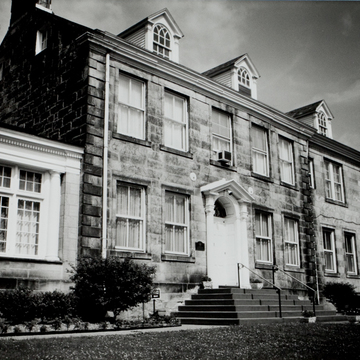You are here
Monument Place (Shepherd Hall)
In 1803 Thaddeus Mason Harris wrote, in his Journal of a Tour into the Territory Northwest of the Allegheny Mountains, that he “dined at Shepherd's Mills on Wheeling Creek,” and observed that “the proprietor of these mills resides in one of the best built and handsomest stone houses we saw on this side of the mountains.” The proprietor was Moses Shepherd, and he called his handsome stone house Shepherd Hall. The fact that he built it on the site of his pioneer father's Fort Shepherd proved just how far civilization “on this side of the mountains” had come by the waning years of the eighteenth century.
The original house is the two-story, five-bay central section of the expanded building seen today. The facade is laid in beautifully cut, smooth, coursed ashlar blocks with quoining, while other walls are faced in coursed rubble. An impressive doorway, the most notable exterior feature, is matched by elegant interior trim. The entire front section of the second floor is one room. Here the Shepherds entertained notables such as their friend Henry Clay, the Marquis de Lafayette (who visited Wheeling in 1825), and, of course, Thaddeus Harris.
A later owner christened the house Monument Place, but the name derived from a monument the Shepherds erected on the lawn in 1820. Attributed to an English artist named John Erie (or Arey), it stood 20 feet high. Although most early observers admired it, the Duke of Saxe-Weimar did not. He described it as “a statue of liberty, coarsely sculptured in sandstone, placed on a clumsy pedestal ornamented with inscriptions and bas relief.” One of the inscriptions explained that it was “erected by Moses and Lydia Shepherd as a testimony of respect to Henry Clay, the eloquent defender of national rights and national independence.” Clay was also a champion of the National Road, a more likely reason the Shepherds sought to honor him. He passed by many times and was present at the monument's dedication. Over the years, the sandstone spalled, and in 1879 an account published in The Industries of Wheeling described it as “the outline of what was once a very imposing monument, but now so obliterated as to be almost unintelligible.” Even so, the WPA guide to West Virginia described it as intact in 1941, and Landmarks of Old Wheeling, published in 1943, contains a photograph. Unfortunately, the decaying monument was later destroyed by fire while in storage at Oglebay Park.
In the 1920s, Monument Place was purchased by the Osiris Temple, a Masonic lodge, which still maintains it. In spite of additions and alterations, the house survives as the first formal Federal house in the Northern Panhandle.
Writing Credits
If SAH Archipedia has been useful to you, please consider supporting it.
SAH Archipedia tells the story of the United States through its buildings, landscapes, and cities. This freely available resource empowers the public with authoritative knowledge that deepens their understanding and appreciation of the built environment. But the Society of Architectural Historians, which created SAH Archipedia with University of Virginia Press, needs your support to maintain the high-caliber research, writing, photography, cartography, editing, design, and programming that make SAH Archipedia a trusted online resource available to all who value the history of place, heritage tourism, and learning.

